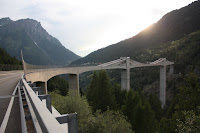 Say for instance you are visiting Switzerland on a whim on a free day after some business meetings in Italy, you have enjoyed a couple of hours of James Bond-like driving on narrow, guardrail-less, switchback Alpine roads, and you come around a bend toward Simplon Pass on the way back to your hotel in Italy, and, wham, there it is...
Say for instance you are visiting Switzerland on a whim on a free day after some business meetings in Italy, you have enjoyed a couple of hours of James Bond-like driving on narrow, guardrail-less, switchback Alpine roads, and you come around a bend toward Simplon Pass on the way back to your hotel in Italy, and, wham, there it is...I happened upon the Ganter River Bridge between Brig, Switzerland, and Simplon Pass, which leads back down to Italy. The stunning concrete structure was designed by the Swiss engineer Christian Menn and completed in 1980. At 2,224 feet total length and a main span of 571 feet, it is the longest bridge in Switzerland. A sort of hybrid concrete girder and cable-stayed bridge, Wikipedia says it could be an example of a type of bridge known as an "extradosed bridge."
 I do not recall where, but I have actually seen photographs of this bridge in the past. But I definitely never expected to see it on this particular drive! What is not evident in any of the photographs I had seen before but is clearly evident when you drive across the bridge is that it does not span straight across the valley. Instead, the approaches from either side form a kind of S-curve with the main span in the center, making for a more dynamic and delightful drive through the mountains. Unfortunately, the light was fading and it was getting late in the day with a long drive back to my hotel or I would have tried to spend some more time exploring the bridge and its environs. I really wanted to walk across it, but there were no sidewalks or shoulders on it, even though there were places to pull-off at the end of each approach.
I do not recall where, but I have actually seen photographs of this bridge in the past. But I definitely never expected to see it on this particular drive! What is not evident in any of the photographs I had seen before but is clearly evident when you drive across the bridge is that it does not span straight across the valley. Instead, the approaches from either side form a kind of S-curve with the main span in the center, making for a more dynamic and delightful drive through the mountains. Unfortunately, the light was fading and it was getting late in the day with a long drive back to my hotel or I would have tried to spend some more time exploring the bridge and its environs. I really wanted to walk across it, but there were no sidewalks or shoulders on it, even though there were places to pull-off at the end of each approach.There is something amazing to me about the integration of the natural and the man-made, especially in "extreme" environments such as the Swiss Alps. I suppose that there is something romantic about idea of unspoiled nature, but I almost wonder if to see nature is to, by definition, defile it. On the other hand, I have always enjoyed those natural places where man has touched down and shown his hand lightly, respectfully, gently.
This bridge is an example of that gentle hand amidst stunning natural settings or phenomena, but there are many examples in the world, and a few spectacular ones that I have had the privilege of visiting myself: Machu Picchu, impossibly perched atop the Andes in Peru, with its exquisite stone buildings echoing the profiles of the mountains themselves; or the Pantheon in Rome, which turns a beam of light into a real, physical entity as it streams through the mighty oculus to illuminate architectural details almost two millennia old.
I am sure this is the designer speaking in me, but I do believe that architecture and design have an opportunity to frame the natural world in an important way. By doing so, the respectful man-made work acts as a foil by which to reflect on the natural in a new light. After all, saying what something is is only one way of defining it. Another way is to show something in opposition so as to definite it by what it is not, in order to call the defined out as something different, special, set apart.

1 comment:
An excellent post. You're a good writer.
Post a Comment